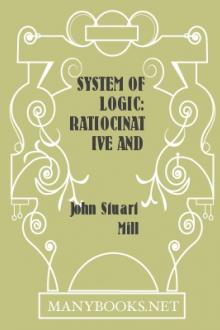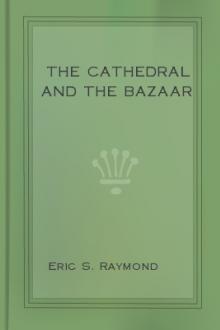A System of Logic: Ratiocinative and Inductive, John Stuart Mill [best books to read now .txt] 📗

- Author: John Stuart Mill
- Performer: -
Book online «A System of Logic: Ratiocinative and Inductive, John Stuart Mill [best books to read now .txt] 📗». Author John Stuart Mill
It is true that for these simply descriptive operations, as well as for the erroneous inductive one, a conception of the mind was required. The conception of an ellipse must have presented itself to Kepler's mind, before he could identify the planetary orbits with it. According to Dr. Whewell, the conception was something added to the facts. He expresses himself as if Kepler had put something into the facts by his mode of conceiving them. But Kepler did no such thing. The ellipse was in the facts before Kepler recognised it; just as the island was an island before it had been sailed round. Kepler did not put what he had conceived into the facts, but saw it in them. A conception implies, and corresponds to, something conceived: and though the conception itself is not in the facts, but in our mind, yet if it is to convey any knowledge relating to them, it must be a conception of something which really is in the facts, some property which they actually possess, and which they would manifest to our senses, if our senses were able to take cognizance of it. If, for instance, the planet left behind it in space a visible track, and if the observer were in a fixed position at such a distance from the plane of the orbit as would enable him to see the whole of it at once, he would see it to be an ellipse; and if gifted with appropriate instruments and powers of locomotion, he could prove it to be such by measuring its different dimensions. Nay, further: if the track were visible, and he were so placed that he could see all parts of it in succession, but not all of them at once, he might be able, by piecing together his successive observations, to discover both that it was an ellipse and that the planet moved in it. The case would then exactly resemble that of the navigator who discovers the land to be an island by sailing round it. If the path was visible, no one I think would dispute that to identify it with an ellipse is to describe it: and I cannot see why any difference should be made by its not being directly an object of sense, when every point in it is as exactly ascertained as if it were so.
Subject to the indispensable condition which has just been stated, I cannot conceive that the part which conceptions have in the operation of studying facts, has ever been overlooked or undervalued. No one ever disputed that in order to reason about anything we must have a conception of it; or that when we include a multitude of things under a general expression, there is implied in the expression a conception of something common to those things. But it by no means follows that the conception is necessarily pre-existent, or constructed by the mind out of its own materials. If the facts are rightly classed under the conception, it is because there is in the facts themselves something of which the conception is itself a copy; and which if we cannot directly perceive, it is because of the limited power of our organs, and not because the thing itself is not there. The conception itself is often obtained by abstraction from the very facts which, in Dr. Whewell's language, it is afterwards called in to connect. This he himself admits, when he observes, (which he does on several occasions,) how great a service would be rendered to the science of physiology by the philosopher "who should establish a precise, tenable, and consistent conception of life."[4] Such a conception can only be abstracted from the phenomena of life itself; from the very facts which it is put in requisition to connect. In other cases, no doubt, instead of collecting the conception from the very phenomena which we are attempting to colligate, we select it from among those which have been previously collected by abstraction from other facts. In the instance of Kepler's laws, the latter was the case. The facts being out of the reach of being observed, in any such manner as would have enabled the senses to identify directly the path of the planet, the conception requisite for framing a general description of that path could not be collected by abstraction from the observations themselves; the mind had to supply hypothetically, from among the conceptions it had obtained from other portions of its experience, some one which would correctly represent the series of the observed facts. It had to frame a supposition respecting the general course of the phenomenon, and ask itself, If this be the general description, what will the details be? and then compare these with the details actually observed. If they agreed, the hypothesis would serve for a description of the phenomenon: if not, it was necessarily abandoned, and another tried. It is such a case as this which gives rise to the doctrine that the mind, in framing the descriptions, adds something of its own which it does not find in the facts.
Yet it is a fact surely, that the planet does describe an ellipse; and a fact which we could see, if we had adequate visual organs and a suitable position. Not having these advantages, but possessing the conception of an ellipse, or (to express the meaning in less technical language) knowing what an ellipse was, Kepler tried whether the observed places of the planet were consistent with such a path. He found they were so; and he, consequently, asserted as a fact that the planet moved in an ellipse. But this fact, which Kepler did not add to, but found in, the motions of the planet, namely, that it occupied in succession the various points in the circumference of a given ellipse, was the very fact, the separate parts of which had been separately observed; it was the sum of the different observations.
Having stated this fundamental difference between my opinion and that of Dr. Whewell, I must add, that his account of the manner in which a conception is selected, suitable to express the facts, appears to me perfectly just. The experience of all thinkers will, I believe, testify that the process is tentative; that it consists of a succession of guesses; many being rejected, until one at last occurs fit to be chosen. We know from Kepler himself that before hitting upon the "conception" of an ellipse, he tried nineteen other imaginary paths, which, finding them inconsistent with the observations, he was obliged to reject. But as Dr. Whewell truly says, the successful hypothesis, though a guess, ought generally to be called, not a lucky, but a skilful guess. The guesses which serve to give mental unity and wholeness to a chaos of scattered particulars, are accidents which rarely occur to any minds but those abounding in knowledge and disciplined in intellectual combinations.
How far this tentative method, so indispensable as a means to the colligation of facts for purposes of description, admits of application to Induction itself, and what functions belong to it in that department, will be considered in the chapter of the present Book which relates to Hypotheses. On the present occasion we have chiefly to distinguish this process of Colligation from Induction properly so called; and that the distinction may be made clearer, it is well to advert to a curious and interesting remark, which is as strikingly true of the former operation, as it appears to me unequivocally false of the latter.
In different stages of the progress of knowledge, philosophers have employed, for the colligation of the same order of facts, different conceptions. The early rude observations of the heavenly bodies, in which minute precision was neither attained nor sought, presented nothing inconsistent with the representation of the path of a planet as an exact circle, having the earth for its centre. As observations increased in accuracy, and facts were disclosed which were not reconcileable with this simple supposition; for the colligation of those additional facts, the supposition was varied; and varied again and again as facts became more numerous and precise. The earth was removed from the centre to some other point within the circle; the planet was supposed to revolve in a smaller circle called an epicycle, round an imaginary point which revolved in a circle round the earth: in proportion as observation elicited fresh facts contradictory to these representations, other epicycles and other excentrics were added, producing additional complication; until at last Kepler swept all these circles away, and substituted the conception of an exact ellipse. Even this is found not to represent with complete correctness the accurate observations of the present day, which disclose many slight deviations from an orbit exactly elliptical. Now Dr. Whewell has remarked that these successive general expressions, though apparently so conflicting, were all correct: they all answered the purpose of colligation; they all enabled the mind to represent to itself with facility, and by a simultaneous glance, the whole body of facts at the time ascertained: each in its turn served as a correct description of the phenomena, so far as the senses had up to that time taken cognizance of them. If a necessity afterwards arose for discarding one of these general descriptions of the planet's orbit, and framing a different imaginary line, by which to express the series of observed positions, it was because a number of new facts had now been added, which it was necessary to combine with the old facts into one general description. But this did not affect the correctness of the former expression, considered as a general statement of the only facts which it was intended to represent. And so true is this, that, as is well remarked by M. Comte, these ancient generalizations, even the rudest and most imperfect of them, that of uniform movement in a circle, are so far from being entirely false, that they are even now habitually employed by astronomers when only a rough approximation to correctness is required. "L'astronomie moderne, en détruisant sans retour les hypothèses primitives, envisagées comme lois réelles du monde, a soigneusement maintenu leur valeur positive et permanente, la propriété de représenter commodément les phénomènes quand il s'agit d'une première ébauche. Nos ressources à cet égard sont même bien plus étendues, précisément à cause que nous ne nous faisons aucune illusion sur la réalité des hypothèses; ce qui nous permet d'employer sans scrupule, en chaque cas, celle que nous jugeons la plus avantageuse."[5]
Dr. Whewell's remark, therefore, is philosophically correct. Successive expressions for the colligation of observed facts, or in other words, successive descriptions of a phenomenon as a whole, which has been observed only in parts, may, though conflicting, be all correct as far as they go. But it would surely be absurd to assert this of conflicting inductions.
The scientific study of facts may be undertaken for three different purposes: the simple description of the facts; their explanation; or their prediction: meaning by prediction, the determination of the conditions under which similar facts may be expected again to occur. To the first of these three operations the name of Induction does not properly belong: to the other two it does. Now, Dr. Whewell's observation is true of the first alone. Considered as a mere description, the circular theory of the heavenly motions represents perfectly well their general features: and by adding epicycles without limit, those motions, even as now known





Comments (0)